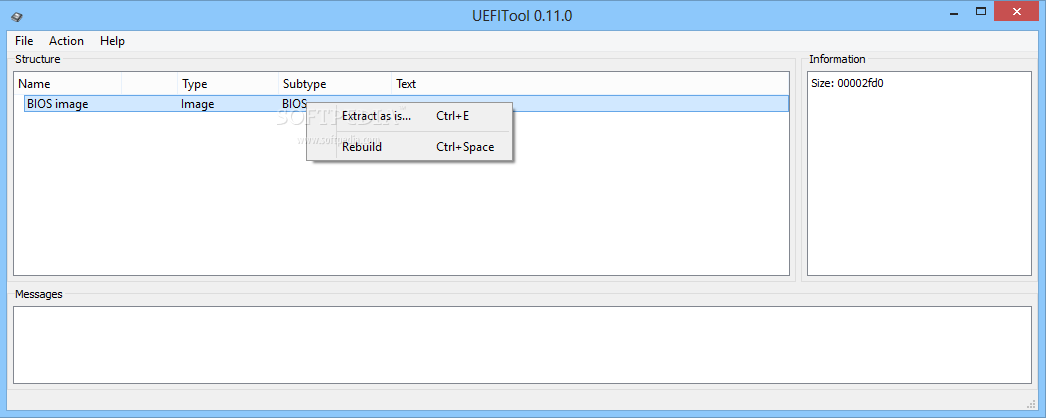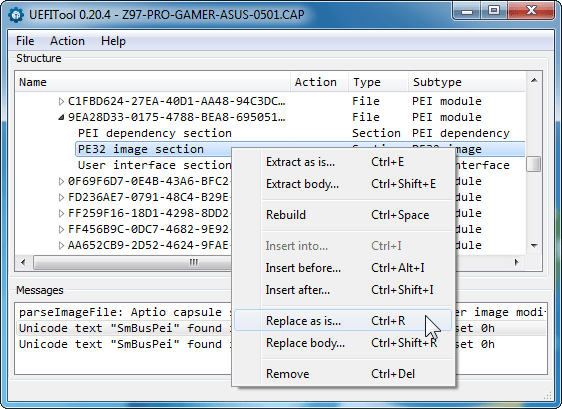

Uefitool linux full#
It supports parsing of full BIOS images starting. It also allows you to open a menu in each element from the tree to see the possible operations, that includes extraction (of the element with its header, or only the element data), insertion, replacement, deletion and reconstruction (to be able to reconstruct the modified UEFI image with UEFITool, taking into account the elements marked for construction and ignoring those that are not). UEFITool is a cross-platform C++/Qt program for parsing, extracting and modifying UEFI firmware images. Most messages can be double-clicked to select the item that caused the message for quick detection. Messages- Displays all engine messages, including search results and structure warnings.Info:… The information panel will show the information available about the selected item based on its type and content.
Uefitool linux Pc#
Structure: the tree of elements with different names, types and subtypes is presented. The HP PC Hardware Diagnostics UEFI Tool is a comprehensive set of tests for identifying, isolating and diagnosing hardware issues.Once that is done, you will see that the work window is divided into three main panels: Very Brief Introduction to UEFI Unified Extensible Firmware Interface or UEFI is a post-BIOS firmware specification originally written by Intel for Itanium architecture and than adapted for X86 systems. You just have to start it without any argument from the command line or with an argument that indicates the path of the UEFI image file that you want to open at startup. UEFITool is a viewer and editor of firmware images conforming to UEFI Platform Interface (PI) Specifications. Supports the image management Complete BIOSes in a more comfortable way, starting with the flash descriptor or any binary file that contains UEFI volumes. With him you can analyze, extract, and modify UEFI firmware images. This program has been programmed in C ++ and using Qt, it is open source and cross-platform. If you are interested in working with firmware images, this tool will surely help you a lot. That is why it is interesting to know tools like UEFITool. This standard has been extended beyond x86 platforms, and many others have incorporated support for it in their ecosystems, such as the case of RISC-V as we informed you from LxA a while ago. I succeeded in removing legacy ROM and network uefi modules.UEFI It came to solve some limitations and BIOS problems.
Uefitool linux free#
The point is the total Bytes Free at the end of the report. I have sent report to Stasio using TweakTown Forum PM, and hope it will be corrected soon.Ĭlick to expand.I saw this too when i tried with z68xp bios. That's why some GB files are having debug-message about intersections in version 0.7.0. The current setup is dangerous by security means (Descriptor, GbE and ME regions are accessible, because they are parts of BIOS region now), it breaks Intel specifications, breaks normal use of FITC utility and simply damn wrong! This setup will have no unallocated space in SPI chip and no intersections between flash regions. So, the right values for BIOS base and BIOS limit should be 0x0200 and 0x07FF respectively. BIOS region starts at offset 0x0000 and ends at 0x800000 (0x7FF + 1)* 0x1000, which is obviously incorrect!īIOS regions should start at any offset between 0x200000 (end of ME region) and 0x250000 (begin of first firmware volume in image file) and end at the end of image file at offset 0x800000. ME region starts at offset 0x3000 and ends at 0x200000 (0x1FF + 1)* 0x1000, which is correct.ģ. GbE region starts at offset 0x1000 and ends at 0x3000 (0x02 + 1) * 0x1000, which is correct.Ģ.

So, this region map says to us (and to chipset logic too, if flashed to SPI chip as is) that:ġ. Orange - upper bytes of BIOS region limitĭark-blue - upper bytes of GbE region limit If you don't familiar with structure of Intel descriptor region, here is an annotated HxD-screenshot of affected part: During the debugging of strange behavior of using UEFITool with Gigabyte BIOSes, I have found either a bug or a special non-standard region map configuration in all recent Gigabyte BIOS images.


 0 kommentar(er)
0 kommentar(er)
